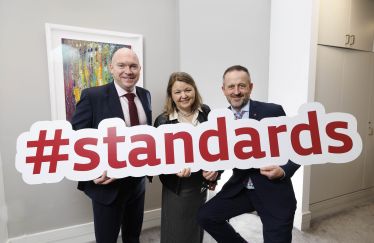NSAI is urging members of the public to become more familiar with some of the risks associated with Carbon Monoxide (CO) in their homes and workplaces.
Carbon monoxide is a very toxic gas that cannot be detected by human senses and there is absolutely no warning if it is present in the home or workplace. NSAI are urging the public to make their homes and businesses safer by installing Carbon Monoxide alarms. However, be aware of safety features and standards when buying carbon monoxide alarms. Take note of the following important preventative safety tips that can help ensure a safe home or workplace.
1. Signs of carbon monoxide: The following indicators may be noted around the house and in rooms where there is a solid fuel burning appliance:
- Staining, sooting or discolouration around the heating appliance and around vents.
- Condensation on walls and windows, and a strange smell when the appliance is on.
- A yellow or orange flame where normally blue for a gas appliance.
- Blockages in chimneys and flues.
- Any damage to or around appliances and flues.
2. Regular servicing and maintenance: The most common cause of carbon monoxide is from faulty or poorly maintained appliances. It is essential to service your oil and gas boilers annually. Ensure that gas boilers are serviced by Registered Gas Installers (RGI). Ask your service technician to check all air vents, chimneys and flues to make sure they are clear of obstruction and to increase fresh air circulation in rooms.
3. Keep air vents clear: Blocked vents, flues and chimneys are a major cause of carbon monoxide. Check your flues and chimneys and outside vents for blockages, overgrowth of ivy and for bird’s nests. Even in cold weather it is essential to keep all air vents clear of obstruction. Have the chimney or flue swept once a year.
4. Install Carbon Monoxide alarms: It is advisable to install more than one carbon monoxide alarm in your home or business. Follow the manufacturer's instructions for installation and positioning. Position alarms next to bedrooms and in rooms with heating appliances. CO alarms are a warning device and do not eliminate CO. Replace the CO alarm once it has reached its expiry date, detailed on the product by the manufacturer. Aim to purchase an alarm that records when carbon monoxide was detected. Carbon monoxide maybe present for a brief period of time when the householder is out. On return, the alarm will indicate that carbon monoxide was detected and a professional can then be called to investigate the source. Never fall into a false sense of security just because a CO alarm has been installed.
5. Look for the quality marks on your CO alarm: Invest in quality CO alarms (from €40-€50) that comply with the appropriate European Standard, EN 50291. Look for the 'CE mark', or for 3rd party certification marks such as the 'BSI Kitemark'. Try to ensure that your CO alarms are fitted with a fault signal with an 'end-of-life indicator'.
Standards are constantly being updated and amended to ensure that the latest advancements in safety and technology are incorporated into consumer products. NSAI continues to work with European and Irish industry to ensure that the qualities of products available on the Irish market are up to standard.
Links
- Carbon Monoxide The Facts
- RGI: Registered Gas Installer
- Bord Gáis Networks Safety Advice
- Carbon Monoxide Week Details from September 2012



